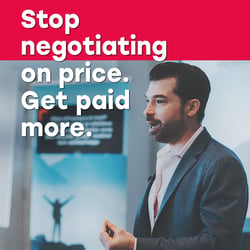Are you the kind of salesperson who is always blindly following the crowd? While many won’t admit it, the hard truth is that most sales reps blindly follow the crowd’s hype in many ways, particularly when it comes to their B2B sales techniques.
Deny it all you want, but most hyped-up selling techniques are overrated and outright USELESS. Not only that, but most sales reps simply use the techniques because they’re blindly following the crowd.
That said, we’re sharing 5 of the most overrated and useless B2B sales techniques! We’re also sharing why they’re so useless, and which techniques you should be using instead.
Sure, keep using these overrated techniques, but you’ll likely get the same results that most other teams get, including:
- Ghosting prospects
- Sales plateaus
- Anxiety-ridden sales cycles
Moreover, keep using these techniques if you want to do anything but close more deals in less time!
Remember, just because every other B2B salesperson on earth buys into the hype doesn’t mean that they’re right and that you should follow their lead.
Why These 5 Selling Techniques Never Work
There is a single, core reason why these 5 overhyped business-to-business sales techniques are a total bust.
The reason is that they take control of the selling process out of your hands and put it into the potential customer’s hands.
When YOU aren’t in control of the selling process, prospects stop seeing you as an expert sales professional and start seeing you as a replaceable vendor who they can afford to live without.
Although you know your qualified leads need you, they see you as completely disposable... Hence, why closing new deals becomes nothing short of a circus.
From now on, the center of your B2B sales strategy is about taking back control of the selling and buying processes by using the right techniques and tactics.
In little to no time, prospects start to see you as an irreplaceable expert!
How to Actually Improve B2B Sales With This Sales Strategy!
Again, the key to sales success is using techniques that keep you in control of the selling process, so that you become an irreplaceable expert.
If your sales strategy isn’t all about control and expertise, then consider everything else a bust!
Still not picking up what we’re putting down?
From now on, stop thinking of yourself as a disposable sales rep and start thinking of yourself as an expert surgeon who nobody questions. Nobody questions you because, at the end of the day, you are the expert who calls the shots!
If you can change your entire sales approach to be like that of a surgeon, then the entire sales strategy falls into place, and the potency of your selling techniques will run deep.
-min-Mar-05-2022-03-23-12-59-AM.png?width=900&name=1%20(1)-min-Mar-05-2022-03-23-12-59-AM.png)
Here are 5 Overrated & Outright Terrible B2B Sales Techniques
If you want to close more deals in less time, then using any one of these 5 B2B sales techniques that take control out of your hands should be the last thing on your mind!
In fact, you should only use these selling techniques if you want to do the opposite of making more sales in less time.
Bottom line: If these extremely common techniques were as effective as they’re often hyped up to be, then there would be many more successful B2B sales teams out there!
1. Consultative Selling
To begin with, consultative selling techniques are those in which sales reps “consult” prospects on their pain points. More specifically, rather than doing the digging themselves, they simply ask prospects what their pain points are and what they and their sales team can do to help.
Sounds good, right? If you really want to help a prospect, isn’t it a simple matter of asking them what they need and then filling the need?
WRONG.
In short: Effective B2B sales reps NEVER use consultative selling techniques, because they know that their ideal customers don’t know ANYTHING about their pain points.
Because they know that prospects don’t know anything about their pain points, they don’t open the door for prospects to tell them what they need and how they need it. Instead, they’re the ones telling prospects what they need and how they need it.
Don’t believe it?
Ask yourself this: If prospects know what their pain points are and how to solve them, then why would they ever need you and your deliverable?
Customers Don’t Know What Their Pain Points Are
We’ll say it louder for the people in the back: Your prospects literally have no idea what their pain points are or how to solve them! If they did, then you would serve no purpose in their life!
That said, using consultative selling techniques as if customers know what they need is a dead-end game.
If you’re not going to step up to the plate and tell prospects what they need and why they need it, then they’ll dispose of you before you ever get the chance to help them.
Do Surgeons Let Patients Self-Diagnose?
Would a surgeon let their patients self-diagnose and tell them what operation they need done in order to feel better? Of course not!
Similarly, you should never allow prospects to self-diagnose themselves.
Instead of using consultative selling techniques, act as doctors do during appointments with patients: ask prospects plenty of in-depth questions, run some analyses, and then offer a diagnosis and solution.
The key is to ask plenty of questions so that you understand the prospect’s problem to the fullest extent. By doing so, you:
- Know exactly what the prospect needs delivered;
- Know exactly how the prospect needs it delivered; and
- Foster the best possible customer buying process
Furthermore, if you don’t play the role of a doctor, then prospects will all of a sudden step in and take the lead!
2. Soft B2B Closing Techniques
Question for you: Would an expert surgeon who is deeply concerned about your well-being ever beat around the bush? When they realize that you need surgery in order to live a healthy life, don’t you think they would tell you the hard truth, regardless of how difficult it is for you to swallow?
Of course they would!
Just like how surgeons use hard closing techniques to set their patients up for success, you should be doing the same with your prospects. Once you understand their problem and what it’ll take to solve it, you need to close the deal on those hard truths.
Plainly stated: You need to close the deal with hard closing techniques!
Unless you close out on a hard note, the prospect won’t take you and your deliverable seriously. Suddenly, they’ll start questioning whether or not they need you at all.
Unfortunately, many sales teams are under the assumption that hard closing techniques are somehow harsh and intimidating. Instead of closing on hard techniques, they try to close on a lighter note by using so-called “soft closing techniques”.
Just like how surgeons tell their patients the hard truth so that they guide their patients to living healthier lives, you need to do the same with prospects.
NEVER Use the Question Close
Perhaps the WORST of all the soft closing techniques is the question close.
The question close is one in which sales teams end their final sales pitch by posing questions to the prospects, such as, “What do you think the answer to the problem is?” or “If you were us, what do you think you’d do?”
Here’s the thing: If you just went through the entire B2B sales cycle only to ask the prospect what they think the solution is, then you’re truly not an expert. Rather, you’re a vendor.
Would an expert doctor ever say to their patient, “Okay so I know I’m the expert here, but what do you think the problem is and how we can fix it?”
While you might think you’re being nice by closing on a supposedly soft note, you’re only shooting yourself in the foot.
Get Acquainted With Decision-Makers
How often does this happen to you: You nail the final sales pitch, slam the deal down on the table, and can tell that the prospects are pumped! But despite their excitement, they hit you with a hard, “We need to run this by some people, and then we’ll get back to you.” What you thought would be an immediate signature on the dotted line all of a sudden becomes an endless waiting game, because the prospects don’t have total authority to make purchasing decisions on their own. Instead, they need to connect with other stakeholders before giving you a “Yes”.
Whenever this happens, all the power goes back into the hands of prospects. Instead of you being in control, you’re back at their mercy! Worse than that, the more time in-between you laying the deal down and getting a response, the less likely you are to close the deal.
Rather than losing power right at the very end of the game, prevent that from happening altogether by getting acquainted with the decision-makers right off the bat. Or even better, get the decision-makers involved in the entire selling process.
By doing so, you prevent ever being hit with a “We’ve got to get the okay first” altogether.

3. Selling the Problem
There’s this persuasive but outright terrible fear-based selling technique in which you motivate the prospect to make a buying decision by scaring them about their pain point.
Also known as the “selling the problem” sales technique, the idea is that if you scare the prospect about the potential impact of their problem, it’ll motivate them to buy from you.
For example, if you spend sales pitches talking mostly about a prospect’s pain point, particularly that it’s wreaking havoc on their business, it will theoretically motivate the prospect to work with you.
However, not only is this ineffective, but it doesn’t encourage the prospect to want to work with you at all.
Why?
Imagine you go to the doctor’s office because you’re experiencing debilitating back pain. After looking at your scans and asking questions, what does the doctor do? Do they make you extremely feel afraid of the problem to push your thoughts toward surgery? Or, do they educate you on the problem and then offer solutions to make you confident that you’re doing the right thing?
While it sounds like they might work on the surface, fear-based tactics are more likely to scare prospects away from you rather than motivate them to buy from you.
Sell the Pathway Instead
A little fear during the selling process isn’t completely bad. For example, using some fear to hype up the prospect’s sense of urgency can help a little. However, going all-out on fear-based selling techniques will do anything but help you close the deal.
That said, instead of selling the problem, sell the pathway forward.
Think of selling the pathway forward like this: When you go to the doctor, they sell you treatments and their outcomes, not the health problems themselves.
For example, if you need surgery, the surgeon motivates you to move forward by telling you about all the great benefits that you’ll have from undergoing it. Sure, they might use a little bit of fear here and there, but the key is to sell the pathway forward towards a better life instead of the problem itself.
Rather than scaring prospects into a corner, get them excited to work for you by selling them the pathway to success.
Hone In On Their Vision
What makes selling the pathway forward so impactful?
Selling the pathway is effective because it allows prospects to see how your product or service will help bring them closer to their business vision.
At the end of the day, every B2B company exists in order to manifest a specific vision. So if you can frame your product or service in a way that shows prospects that you’re paving the pathway towards their vision, then they see you as virtually irreplaceable.
All of a sudden, they’ll realize that without your product or service, reaching their end destination will be virtually impossible!
4. Negotiating
How often do you get to the end of a sales pitch, lay the deal down on the table, and then all of a sudden get hit with a “Let’s negotiate?” Fewer phrases are more gut-wrenching, particularly right after you give an outstanding pitch!
In short, if a lead asks you and your sales team to negotiate, DON'T do it.
You might think that you’re being nice by dropping the price, but you’re really just setting yourself up to get hurt! And when you start to feel the pain, you’ll eventually pass some of that pain on to the customer.
Ultimately, negotiating hurts both you and the customer!
Want to prevent having to awkwardly negotiate price altogether?
The key is to be extremely tight with lead generation! Instead of simply siphoning as many leads into your sales pipeline as possible, focus on lead quality! High-quality leads are the ones who are least likely to want to negotiate.
Be Fair & Flexible
Just because you shouldn’t negotiate doesn’t mean that you shouldn’t be fair or flexible.
By fair, we mean that your price should accurately reflect the value of your product or service.
By flexible, we mean that if your prospect can’t genuinely afford the price of your deliverable upfront, you can still offer flexibility in terms of payment. For example, payment plans are a great option! Or, ask for a non-monetary payment in exchange for a monetary discount, such as asking the prospect to be a subject for case studies.
Again, while you shouldn’t negotiate, you should always be reasonable.
Would a Surgeon Negotiate Price?
Do you think that an expert surgeon would negotiate the price of surgery? Definitely not. That is, at least, if they want to maintain their expert status!
While they might not negotiate price, surgeons genuinely want the best for their patients, so they’re often willing to offer payment flexibility.
The moment a surgeon opens themself up to negotiation is the moment their expert status starts to slip. Therefore, you shouldn’t do the same yourself!
Instead of negotiating, stand firm in your value, just like a surgeon does!
The Customer Relationship Goes Both Ways
Just like friendships and other personal relationships, supplier-customer relationships are a two-way street. For the relationship to work, both parties need to exchange equal value to one another. If they don't, one of the parties is likely to feel jipped.
That said, if you’re giving prospects 100% effort while dropping price, then it's inevitable that you’ll start to resent them. Over time, the foundation of the customer relationship will begin to erode.
Unless you want to lose your most valuable business asset, then don’t set your relationships with prospects up to fail by negotiating price!

5. Free Initial Proposals
If you’re like just about every other B2B sales rep on the planet, then you absolutely despise handing out free initial proposals like they’re candy.
You absolutely should despise them, because proposals:
- Take hours on end to put together;
- Rarely ever convert leads into B2B customers; and
- Turn the selling process into a months-long, anxiety-ridden ordeal
How often has this happened to you: A potential customer asks you to email them your proposal, so you spend hours throwing together a genius presentation. After sending the proposal out, you sit anxiously waiting only to have the prospect ghost you or take forever to respond only to tell you, “Thanks, but no thanks”.
Bottom line: Instead of being like every other salesperson on earth by sending out proposals, don’t give away high-value information for free. In the end, you’ll preserve your value and stay in control to keep deals on track to close!
Do You Want Prospects to Ghost You?
Getting ghosted by somebody who you think likes you isn’t limited to friendships and relationships! In fact, it’s just as relevant in B2B sales.
Not only that, but getting ghosted by potential B2B buyers is like getting a kick right to the stomach (if you know, you know).
That said, if you want to prevent ghosting altogether, then simply stop hanging out free proposals to potential customers. The moment you send out the proposal is the moment you put 100% of the control into a customer’s hands.
How many more times will you sit anxiously around your computer waiting for a response to your proposal only to be disappointed?
What Does a Proposal Do for the Customer?
Isn’t the selling process supposed to be about understanding customers?
Aren’t you, the sales pro, supposed to be understanding your customers instead of making things all about yourself?
When you go to a doctor’s appointment, does the doctor tell you all about themself, or do they ask you questions about how you’re doing?
Sending out a free proposal is the equivalent of going to the doctor and, instead of the doctor asking you about your symptoms, they start listing off their credentials and how cool they are. Sure, it might reassure you that they’re a good doctor, but aren’t you there for treatment?
Remember, the selling process is a simple matter of understanding customers! And trying to understand customers by sending a proposal is completely counterintuitive.
The B2B Sales Process Drags on Forever
So, in best-case scenarios, your potential customer is still interested in talking after you send them your proposal. But how long on average does it take them to come to that conclusion?
One week? Two weeks? One month?
More likely than not, it takes them at the very least one week to respond to you. During that time, you’re probably biting your nails waiting for your fate to be decided.
Not only is it annoying for the sales process to drag on forever thanks to the customer’s inaction, but the longer the sales process drags on, the less likely the customer is to make a purchasing decision.
Moreover, just because the prospect responds to your proposal does not make it likely for them to buy from you.
Final Thoughts on Outright Terrible B2B Selling Techniques
If you don’t consider yourself as somebody who typically follows the crowd simply because of the hype they create, then you aren’t the kind of person who would use these 5 B2B sales techniques.
Sure, go ahead and give them a try! In the end though, you’ll ultimately land in the same situation that most other sales professionals find themselves in: disappointed that results aren’t matching their effort.
Great sales techniques can either be your most effective sales tool or the thing that holds you back from reaching your full potential. Will you continue to follow the crowd’s hype, or join the minority of sales reps who distance themselves from the crowd by ignoring the hype?
You May Also Like
These Related Articles

10 Terrible & Pervasive B2B Sales Tips To Be Aware Of

The Worst B2B Sales Mistakes that Shun Prospects + Simple Fixes




